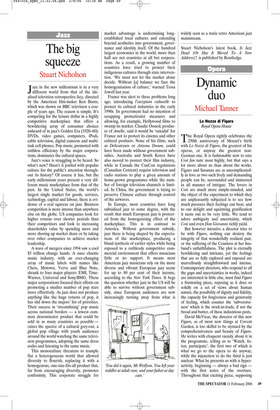The big squeeze
Stuart Nicholson
Jazz in the new millennium is in a very different world from that of the idealised television retrospective Jazz, directed by the American film-maker Ken Burns, which was shown on BBC television a couple of years ago. The reason is simple. It’s competing for the leisure dollar in a highly competitive marketplace that offers a bewildering array of consumer choices unheard of in jazz’s Golden Era (1920–60): DVDs, video games, computers, iPods, cable television, digital cameras and multitask cell phones. Pop music, promoted with ruthless efficiency by the major corporations, dominates the cultural spaces.
Jazz’s voice is struggling to be heard. So what’s new? Hasn’t it jostled with popular culture for the public’s attention throughout its history? Of course it has, but the early millennium years present a very different music marketplace from that of the past. In the United States, the world’s largest single market for goods, services, technology, capital and labour, there is evidence of a real squeeze on jazz. Business competition is more intense than anywhere else on the globe. US companies look for higher returns over shorter periods than their competitors and look to increasing shareholder value by spending more and more shoring up market share or by taking over other companies to achieve market leadership.
A wave of mergers since 1994 saw a cool $5 trillion change hands. A once chaotic music industry, with an ever-changing array of music labels with names like Chess, Motown, Verve and Blue Note, shrank to four major players: EMI, TimeWarner, Universal and Sony/BMG. These major corporations focused their efforts on promoting a smaller number of pop stars more effectively. As jazz does not produce anything like the huge returns of pop, it has slid down the majors’ list of priorities. Their success in ‘streamlining’ pop music across national borders — a lowest common denominator product that could be sold in as many countries as possible raises the spectre of a cultural grey-out, a global pop village with youth audiences around the world watching the same television programmes, adopting the same dress codes and listening to the same music.
This monoculture threatens to trample flat a heterogeneous world that allowed diversity to flourish, replacing it with a homogenous, one-size-fits-all product that, far from encouraging diversity, promotes conformity. This corporate struggle for market advantage is undermining longestablished local cultures and extending beyond aesthetics into government, governance and identity itself. Of the hundred largest economies in the world, more than half are not countries at all but corporations. As a result, a growing number of countries have tried to protect their indigenous cultures through state intervention. ‘We must not let the market alone decide. Without [a] balance we face the homogenisation of culture,’ warned Tessa Jowell last year.
France was alert to these problems long ago, introducing l’exception culturelle to protect its cultural industries in the early 1990s. Its government had no intention of scrapping protectionist measures and allowing, for example, Hollywood films to swamp its market. Claudie Ossard, producer of Amélie, said it would be ‘suicidal’ for France not to protect its cinema and other cultural products. None of his films, such as Delicatessen or Arizona Dream, could have been made without government subsidies. Australia and South Korea have also moved to protect their film industry, while in Canada the CanCon regulations (Canadian Content) require television and radio stations to play a given amount of home-grown programmes while the number of foreign television channels is limited. In China, the government is trying to preserve Chinese culture through control of the airwaves.
In Europe, most countries have long subsidised jazz to some degree, with the result that much European jazz is protected from the homogenising effect of the marketplace. This is in contrast to America. Without government subsidy, jazz there is being shaped by the expectations of the marketplace, producing a bland synthesis of earlier styles while being exposed to a ruthlessly competitive commercial environment that offers musicians little or no support. It means most American jazz musicians rely on the more diverse and vibrant European jazz scene for up to 80 per cent of their income, according to the New York Times. It begs the question whether jazz in the US will be able to survive without government subsidy, since European audiences are now increasingly turning away from what is widely seen as a static retro American jazz mainstream.
Stuart Nicholson’s latest book, Is Jazz Dead (Or Has It Moved To A New Address)?, is published by Routledge.














































 Previous page
Previous page